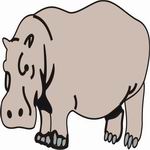- In Greek, hippopotamus means "river horse." This name suits
the hippo, which spends its days in or near water.
- But hippos are not related to horses at all-in fact, their closest
living relative is the pig.
- The Hippo is the 3rd largest animal in the world, next to the elephant
and white rhino, although the hippo is slightly smaller than the white
rhino but much heavier.
- Hippos range in weight from about 1,764-7,056 pounds (800-3200 kg).
- Hippos can open their mouths up to 150 degrees wide.
- The ears and nostrils - located at the top of the head - close automatically
when the animal is under water.
- The hippopotamus does not eat meat at all. It usually feeds on grass,
water-plankton etc.
- It inhabits lowlands and grasslands with enough water supplies.
- Hippos excrete a red liquid from their pores, which protects their
skin from sun and infection.
- Hippos can live up to 45 years in the wild, up to 49 years in captivity.
- Hippos are herbivores that graze at night after the temperature has
cooled.
- Newborn common hippos weigh about 55 to 120 pounds.
- Hippopotamuses are listed as a vulnerable species, primarily because
humans have excessively hunted hippos for their meat, fat, ivory teeth.
- Hippos are hosts to many creatures.
- Birds, such as hammerhead storks and cattle egrets, use hippos as
perches for fishing while hippos stand in water.
- Birds pick flies, ticks and other insects off the skin of hippos.
- These birds do the hippos a favor by removing the pesky bugs.
- The hippo has "T" shaped eyes which allows him to see above
water and below water at the same time.
- Pregnant females actually separate themselves from the herd as the
time of birth nears.
- Typically, common hippo calves are born underwater. They must quickly
swim to the top to catch their first breath, close their nostrils as
their parents do, and then submerge to nurse. Yet it is not quite as
difficult as it might seem: hippo calves are able to do all this only
minutes after birth.
- Common river hippos live in herds of about 10 to 30 animals.
- The dominant male has the right to mate with all females in his herd.
|


